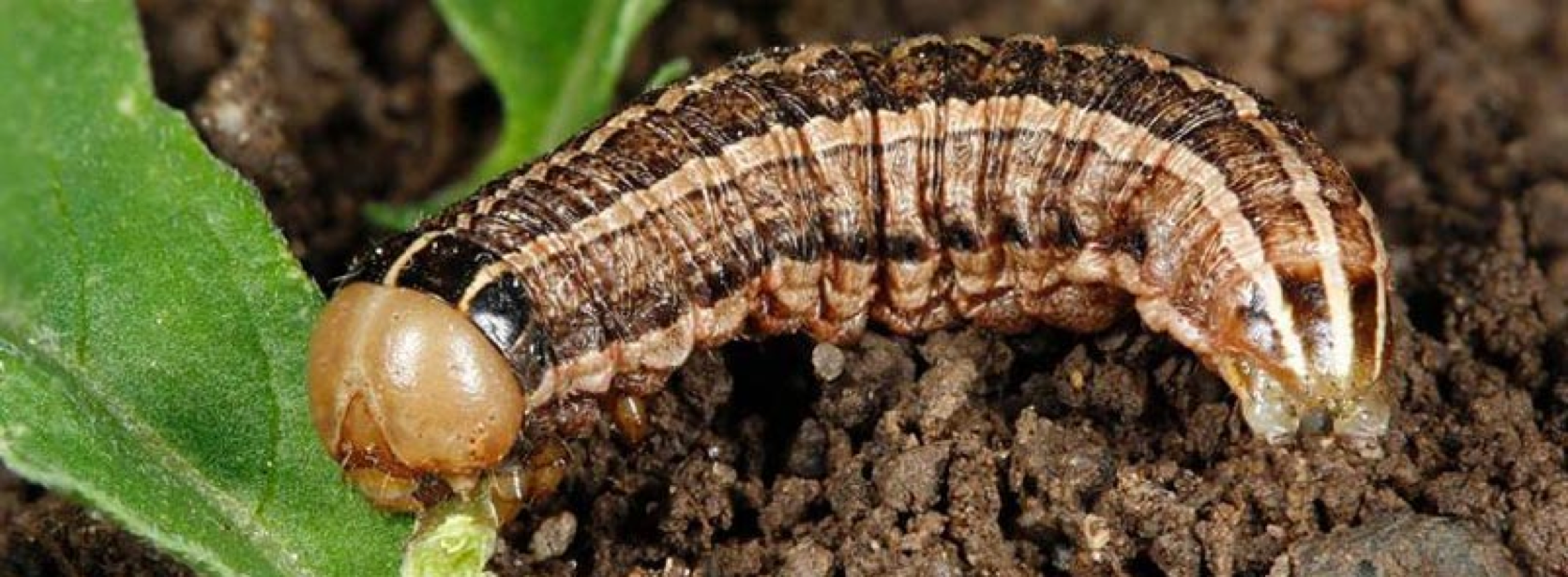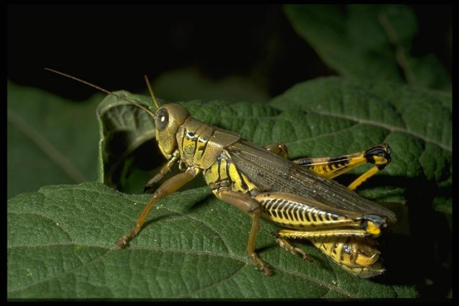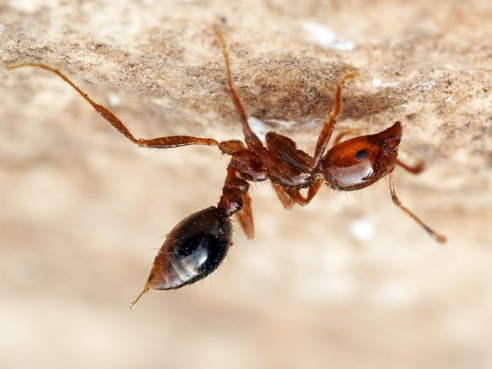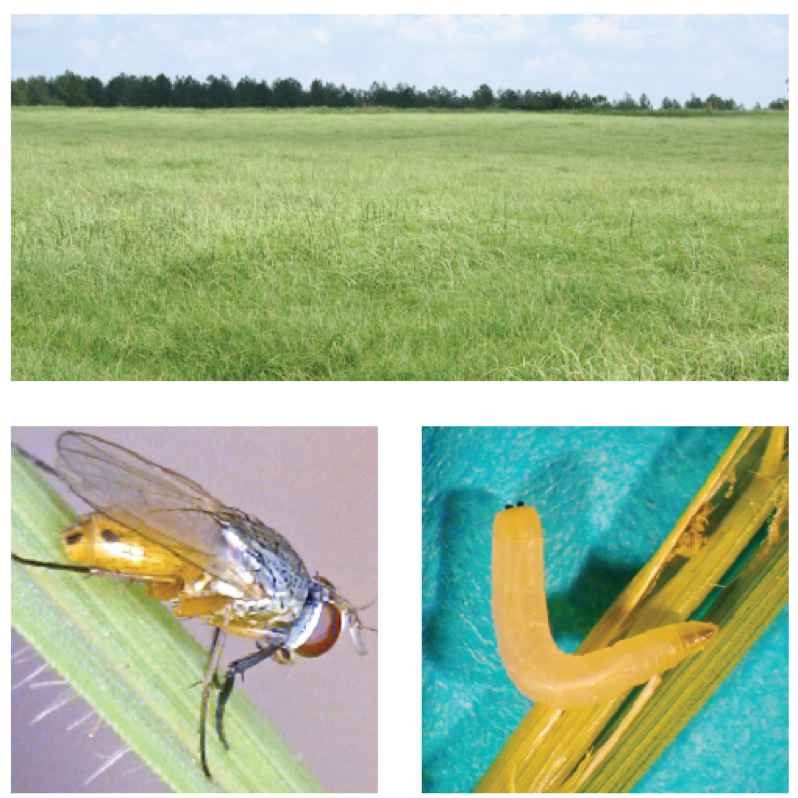
Armyworms (Noctuidae): moth larvae that are major chewing pests of turf and grains. There are several species of these caterpillars, including the Fall Armyworm and the Spring Armyworm. All are semi-social agricultural and garden pests.
- Life Cycle: overwintering pupae molt in spring, adult moths lay masses of eggs on host plants (mainly grasses), 4 week larval feeding period before becoming pupae. There are multiple generations yearly.
- Behavior: caterpillars travel in groups to seek out new food sources (hence the name armyworms), skeletonize leaves as young larvae and devour entire leaves and stems as larger larvae, cause brown spots in lawns.
- Food Source: grains, corn, turfgrass, plants with thick canopies are especially susceptible.
- Management: parasitoid wasps, lacewings devour caterpillars and other pests.
- Armyworm, Pseudaletia unipuncta.

Grasshoppers (Acrididae): chewing insects of many plant species including weeds and grasses. Grasshoppers can grow in population during warm and dry seasons and therefore pose a threat to grasses and agricultural plants. Since there are many grasshopper species, there is a wide range of preferred food. Grasshoppers have nymph stages which are smaller grasshoppers that lack wings.
- Life Cycle: during spring, eggs are laid on undersides of crop leaves, in grasses and in weedy fields and hatch into nymphs which feed on the plants. Nymphs molt and become pupae in the soil before hatching into adults. There is 1 generation yearly.
- Behavior: able to migrate quickly to new plants. While not social, grasshoppers live in large “communities” that include multiple species. They communicate with their wings and hind legs, making loud noises audible to humans.
- Food Source: grasses, weeds, pumpkins, squash, sunflower, corn, grains, tomatoes, sweet potatoes, etc.
- Management: lacewings eat grasshoppers. Pesticide application may be necessary to control large populations during dry seasons. Grasshoppers can kill plants by eating all the vegetation and stems. Apply insecticides to the undersides of plant leaves.
- Pests in Gardens and Landscapes: Grasshoppers.
- https://texasinsects.tamu.edu/differential-grasshopper/.

Red Imported Fire Ants (Formicidae): eusocial pest insects of urban developments, fields, pastures and farms. Fire Ants are most active during warm months, even when it is dry. They build large communal mounds that block harvesting tools, disrupt power technology, and break electrical machinery that are used as mound sites. Fire ants are attracted to electrical currents.
- Life Cycle: the queen lays up to 1000 eggs daily, which become tiny larvae to which the workers tend. After pupating, they either become reproductive adults (including new queens and male drones), or female workers.
- Behavior: aggressive. They will bite and sting any object that enters their nest using formic acid to produce a fiery burn. Works gather soil and begin digging tunnels to produce a mound. Mounds continue to grow and become large obvious piles. The tunnels reach down to the water table. Many workers forage outside of the hive to scout for enemy ants and find food.
- Food Source: human food, other insects including ants, seeds, nuts, fruits, very small lizards and even birds, carcasses.
- Management: apply a dry pellet type pesticide that the ants ingest and kills the queen. With larger populations or farm/garden operations, use a powder that is mixed with water through a sprinkler system to spray the field and eradicate the fire ants.
- Pests of Permanent and Improved Pastures, Texas Cooperative Extension.

Bermudagrass Stem Maggot (Muscidae): fly larva pest of Bermudagrass and Stargrass. The fly is native to Asia, but appeared in the United States in 2010. The fly is small and yellow.
- Life Cycle: eggs are laid on Bermudagrass. After hatching, the larva migrates to the upper stem shoot, where it burrows and begins devouring stem material. The top leaves of the grass die off, but the remainder of the plant remains green. After feeding is complete, the maggot emerges and drops to the earth to pupate. The fly emerges from the ground. It takes around 2.5 weeks for the life cycle to complete.
- Behavior: maggots create a tunnel in the stem, below the dead leaves. The maggot may be seen if this part of the plant is opened. Maggots do not usually infest grazed pasture, since they are eaten by the livestock with the grass.
- Management: grazing. Harvest the grass during the larval stage which will kill the maggots. Apply an insecticide to prevent adult flies from emerging and laying new eggs.
